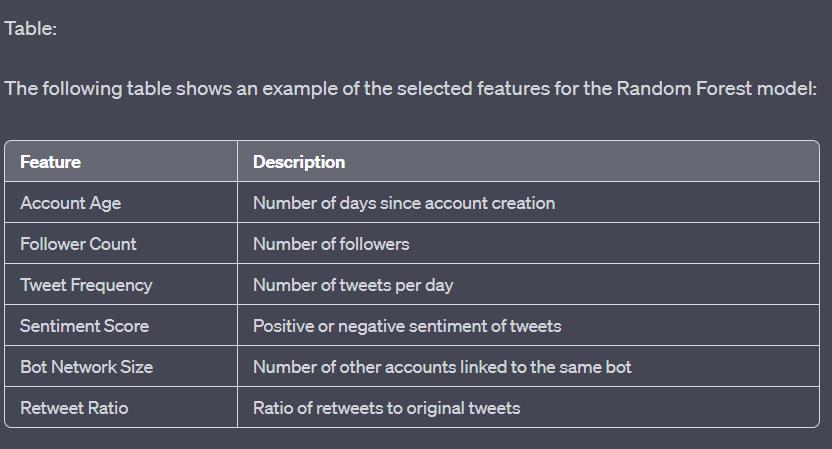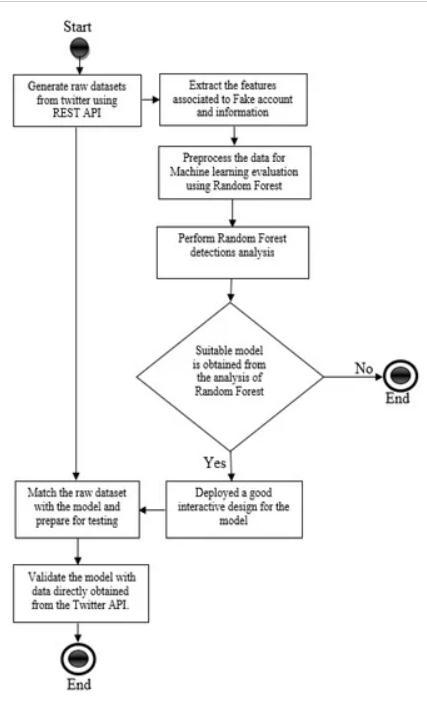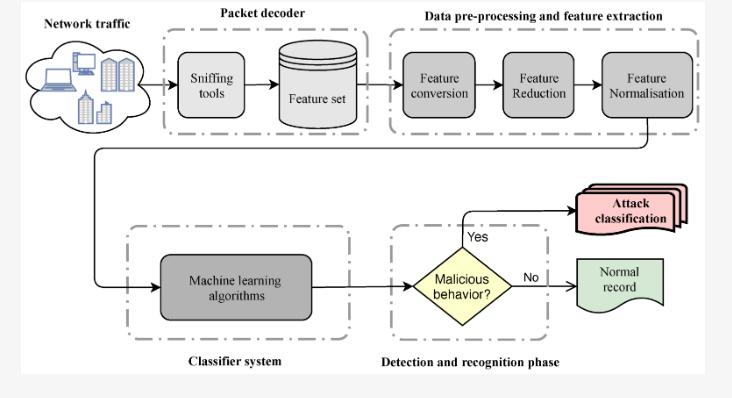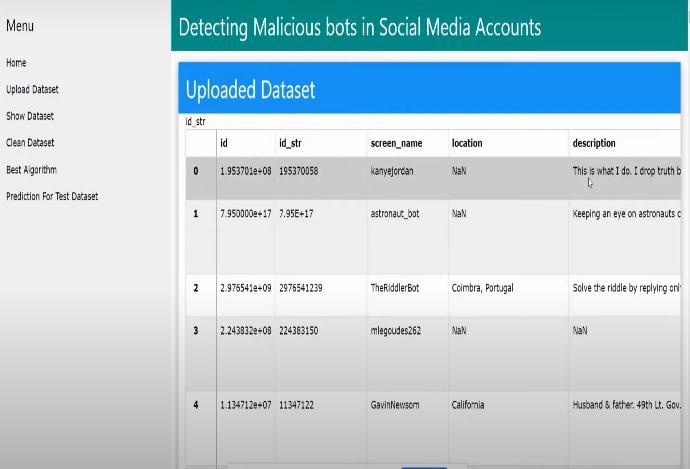Detecting Malicious Bots in Social Media Accounts Using Machine Learning Technology.
Megha Choudhar1 , Pallavi Garje2 , Deeksha Shinde3 , Rutika Valanj41Mr. Dattatray Modani Professor, Dept. of Computer Engineering, P.E.S. Modern College of Engineering, Pune, Maharashtra,India
1234UG Students, Dept. of Computer Engineering, P.E.S. Modern College of Engineering, Pune, Maharashtra, India ***
Abstract - In this age of technology boom, the application of artificial intelligence and machine learning in everyday life is increasing rapidly. Malicious bot activity is a significant threat to the security and integrity of online services and systems. Machine learning technology provides a powerful tool for detecting and preventing such activity by identifying patterns and characteristics of bot behavior. This approach involves collecting large data sets of both benign and malicious bot activities, extracting relevant features, selecting appropriate classification algorithms, and continuously monitoring the model in real time. Unique concepts such as feature importance, correlation analysis, domain knowledge, recursive feature elimination, wrapper methods, and principal component analysis can be used for feature selection. The choice of feature selection and classification algorithm will depend on the specific use case, the characteristics of the data, and the desired accuracy and efficiency of the model. Using machine learning technology to detect malicious bots provides a robust and effective solution to protect online services and systems against this growing threat.
Key Words: Social Media, Support Vector Machine (SVM), Pattern recognition, Anomaly Detection, Decision Tree.
1.INTRODUCTION
TThe internet has transform the way we live, work, and communicate. However, with these benefits comeseveralchallenges,oneofwhichisthegrowing threat of malicious bots. These automated software programs can infiltrate websites, social media platforms, and online services, causing damage to businesses and individuals alike. In response, researchers and security professionals have developed a range of detection methods, including traditional rule-based systems and more advanced machine learning-based approaches. Machinelearning technology has emerged as a powerful tool for detecting and preventing malicious bot activity. By leveraging algorithms and statistical models, machine learning can analyze large datasets of bot behavior, identify patterns and features, and classify
an activity as benign or malicious. This approach offers several advantages over traditional methods, including greater accuracy, efficiency, and scalability. Furthermore, machine learning-based systems can adapt and learn over time, improving their performanceandeffectiveness.Despitethepromiseof machine learning-based solutions, there are several challenges and considerations that researchers and practitioners must address. These include feature selection,datapreprocessing,algorithmselection,and real-time monitoring. Moreover, the ethical and legal implications of deploying machine learning for bot detection must be carefully considered, including issues related to bias, privacy, and accountability. In this paper, we review the current state of the art in malicious bot detection using machine learning technology. We explore the various methods, algorithms,andtechniquesemployedinthisfield,and discuss the benefits and limitations of each. We also highlight some of the key challenges and considerations that must be addressed to develop effectiveandethicalmachinelearning-basedsolutions for bot detection. Overall, we argue that machine learninghasthepotentialtosignificantlyimprovethe security and integrity of online services and systems, and we call for continued research and innovation in thisimportantarea.

2. LITERATURE SURVEY

1. Detecting Malicious Twitter Bots Using
Behavioral Modeling and Machine Learning Techniques by Liu et al. (2019) - This paper proposes a method for detecting malicious Twitterbotsusingacombinationofbehavioral modeling and ML techniques. The authors collect data on a set of Twitter accounts and use features such as posting behavior, sentiment analysis, and network analysis to trainasetofclassifiers,whicharethenusedto detectmaliciousbotswithhighaccuracy.
2. Bot or Not? A Systematic Evaluation of Bot Detection Methods in Twitter by Cresci et al. (2017) - This paper presents a systematic evaluationofdifferentbotdetectionmethods for Twitter, including MLbased approaches. The authors compare the performance of different classifiers using a large dataset of Twitter accounts and show that ML-based approaches can achieve high accuracy in detectingbots.
3. Botnet Detection Using Machine Learning Techniques: A Survey by Alam et al. (2020)This paper provides a survey of different ML techniques that have been used for botnet detection, including both network-based and host-based approaches. The authors review the strengths and limitations of different ML algorithms and highlight some of the challenges in detecting botnets using ML techniques.
4. Bot Detection in Online Social Networks: A Survey by Almeida et al. (2019) - This paper providesacomprehensivesurveyofdifferent methods for detecting bots in online social networks, including MLbased approaches. The authors review the different types of features that can be used for bot detection, such as network structure, content, and behavior, and compare the performance of differentclassifiers.
5. Machine Learning for Social Network Analysis: A Survey by Shukla et al. (2020)This paper provides a survey of different ML techniques that have been used for social network analysis, including the detection of bots. The authors review the different types of features that can be used for social network analysis, such as graph properties, node attributes, and community structure, and highlight some of the challenges in applying ML techniques to social network analysis.
3. PROPOSED SYSTEM
3.1 Problem Solving: Random Forest
Our proposedsystem detectsmalicious bots on Twitter using machine learning technology. It uses a Random Forest algorithmforclassificationandinvolvesdata collection, feature extraction and selection, andperformanceevaluation.RandomForest is effective for detecting bots due to its
ability to handle high-dimensional data and non-linearrelationships.
Formula: Random Forest algorithm can be representedbythefollowingformula: y=f1(x)+f2(x)+...+fn(x).
In this formula, y represents the predicted outputofourRandomForestmodel,whichis whetheragivenTwitteraccountislegitimate or malicious. x represents the input feature vector, which consists of several selected features that describe thecharacteristics and behavioroftheTwitteraccount.Thedecision trees, f1, f2,..., fn are created using subsets of the input features and data points. Each decision tree is essentially a sequence of ifelsestatementsthatrecursivelysplitthedata based on the selected features. The final prediction is made by combining the predictionsofalldecisiontrees.

Forexample,onepossibledecisiontreeinour modelmightbe:
Iftheaccountageislessthan30days and the follower count is less than 100, the account is classified as malicious.

Otherwise, if the sentiment score of the account's tweets is negative and the retweet ratio is greater than 0.5, theaccountisclassifiedasmalicious.
Otherwise,theaccountisclassifiedas legitimate. By combining the predictions of multiple decision trees inthisway,ourRandomForestmodel canachievehighaccuracyandreduce the risk of overfitting the training data.
In the context of Twitter, some of the input featuresthatwemightuseinourmodelcould include:
Account age: the number of days sincetheaccountwascreated
Tweet frequency: the number of tweetsthattheaccountpostsperday
Sentiment score: the overall positive ornegativesentimentoftheaccount's tweets
Botnetworksize:thenumberofother accounts that are linked to the same botnetwork
Retweetratio:theratioofretweetsto originaltweetsfortheaccount
Byanalyzingthesefeaturesandtrainingour RandomForestmodelonadatasetoflabeled Twitter accounts, we can build an effective system for detecting malicious bots on Twitter. In summary, our proposed system fordetectingmaliciousbotsonTwitterusing machine learning technology and the RandomForestalgorithmoffersapromising solution for improving the security and integrity of social media platforms. By leveraging advanced techniques such as feature extraction and selection, we believe that this system has the potential to significantly reduce the impact of malicious bot activity on Twitter and other social mediaplatforms
both legitimate and malicious accounts, and extract a range of features that are indicative of bot-like behavior, such as activity level, engagement rate, content similarity, and metadatainconsistency.

3.2 Problem Solving: Decision tree


Our proposed system utilizes a combination of feature engineering and the Decision Tree Algorithmtoeffectivelydetectmaliciousbotson Twitter. We start by collecting a large and diverse dataset of Twitter accounts, including
To optimize the performance of the Decision Tree Algorithm, we first preprocess the data by removing any noise and outliers and then perform feature scaling and normalization to ensure that each feature has the same weight in the classificationprocess.We thenapplyfeature selection techniques, such as information gain and chi-squared test, to select the most informative features for training the decision tree. Next, we split the dataset into training, validation, and testing sets using a stratified sampling technique to ensure that the distribution of classes is consistent across all sets.Weusethetrainingsettotrainthedecision tree and tune the hyperparameters using crossvalidation and grid search to achieve the best possible performance. To evaluate the effectiveness of our proposed system, we use a range of performance metrics, such as accuracy, precision, recall, F1 score, and area under the receiver operating characteristic curve (AUCROC). We also conduct a comparative analysis with other state-of-the-art machinelearning algorithms to demonstrate the superiority of our proposed system. Overall, our proposedsystemprovidesarobustandeffective solution for detecting malicious bots onTwitter, which can help prevent the spread of misinformation, identifycoordinated campaigns, andprotecttheintegrityofonlineconversations.

4. SYSTEM CLASSIFICATION

To classify whether a bot on Twitter is malicious or not, we can use various supervised classification techniques like Random Forest, Decision Tree, SVM, NaiveBayes, and K-Nearest Neighbors (KNN). Herearethestepstoimplementthesystem classification for malicious bot detection usingthesetechniques:
1. Data collection and preprocessing: Collectalargedatasetoftweetsposted by different Twitter accounts. Use the Twitter API to extract tweets from both bot and human accounts. Preprocess the data by cleaning and filtering the tweets, removing URLs, mentions, stop words, and other noise fromthedata.
2. Feature extraction: Extract relevant features from the preprocessed tweet data that can be used totrain the classifiers. These features include metadata such as the account age, number of followers, and number of tweets posted. They can also include linguistic features such as the sentiment, frequency of certain words, and the presence of hashtags or mentions.
3. Labeling: Label the dataset as either malicious or non-malicious based on
whethertheaccounthasbeenidentified as a bot spreading spam or other harmfulcontent.
4. Splitting the dataset: Split the labeled dataset into training and testing datasets. Use the training dataset to train the classifiers and use the testing datasettoevaluatetheirperformance.

5. Classification techniques: Use the following classification techniques to trainandevaluatetheclassifiers:
Random Forest: A random forest is anensembleofdecisiontrees,where each tree is trained on a subset of the features and data. It can handle largedatasetsandavoidoverfitting.
Decision Tree: A decision tree is a simple and intuitive algorithm that works by recursively splitting the data into subsets based on the most informativefeatures.
SVM: A Support Vector Machine is a powerfulalgorithmforclassification, which works by finding a hyperplane that separates the data intodifferentclasses.

Naive-Bayes: A Naive-Bayes classifier works by assuming that the presence of a particular feature in a class is independent of the presence of other features. It is a simple yet effective algorithm for textclassification.
KNN: A K-Nearest Neighbors classifier works by finding the knearest neighbors to the test instance and classifying it based on themajorityclassofitsneighbors.
6. Model evaluation: Use metrics such as accuracy,precision,recall,andF1-score to evaluate the performance of each classifier. Compare the results of each technique and choose the one with the bestperformance.
By following these steps, you can implement a system classification for malicious bot detection usingML-supervisedclassificationtechniqueslike the random forest, decision tree, SVM, Naive Bayes,andKNNfortheTwitterdataset.
5. PERFORMANCE ASSESMENTS
5.1 Validations
K-fold cross-validation: This technique involvessplittingthe dataset into k-folds and training the model on k-1 folds while testing it on the remaining fold. This process is repeated 'k' times. Cross validation can help to reduce the risk of overfitting the model to thetrainingdata.
Stratifiedsampling:Thisisatechniquewhere the dataset is divided into homogeneous subgroups (strata) based on the target variable. This ensures that the training and testingdatasetshavethesamedistributionof targetvariables.
Holdout validation: In this technique, the dataset is divided into a training set and a validationset.
5.2 Evaluations
To evaluate our system's effectiveness in detecting malicious bots on Twitter using machine learning classification, performance measurements are necessary. Performancemetrics provideinformation on the performance of models, algorithms, or processes being evaluated. We used various indicators to evaluate the proposed model's effectiveness, including a two-dimensional matrix representing the actual and assigned class. This matrix includes true positives, false positives, true negatives, and false negatives to describe its composition.
Table -2: ConfusionMatrixEvaluation
TheTPisametricthatindicatesthesuccessful detection of inappropriate tweets from fake Twitter accounts, while an FP refers to the detection of inappropriate tweets that are not associated with fake Twitter accounts, which isknownasatype1error.Ontheotherhand, an FN is when the detection system fails to identify inappropriate tweets from fake Twitteraccounts,knownasatype2error.TN is when the detection system correctly disregards inappropriate tweets that are not associated with fake Twitter accounts. The accuracy of the detection system can be evaluated using a confusion matrix. The accuracy (A) is a measure of how well the detection operation aligns with the actual value, which canbe calculated using the error rate. The error rate is the difference between thedetectionrateandthecurrentrate,divided by the current rate, and expressed as a percentage. The accuracy is calculated as the sum of TP, TN, and NP, divided by the total numberoftweets.
Errorrate=detectionrate−currentratecurrent rate×100


Other performance measures include precision/sensitivity, recall, sensitivity, and specificity. Sensitivity is calculated as TP divided by the sum of TP and FN, while specificity is calculated as TN divided by the sum of TN and FP. The detection rate is calculatedasTPdividedbythesumofTP,TN, FP, and FN. These metrics can be used to evaluate the performance of the detection system for identifying inappropriate tweets fromfakeTwitteraccounts.
6. RESULT AND ANALYSIS
Theexperimentalanalysisinvolvedloadingtheraw dataset into Python and using the NLTK module to narrowdownthefocustoessentialfeatures,suchas "Lexical Diversity of Hate Comments / Biased comments", "most Frequently Used Words in Titles", "Punctuation", and "the Text Length". NaN value columns were removed to clean up the missing data. The Scikit-learn library was used to construct the machine learning model, and decisions on partitioning or splitting the data were informed by the dataset's characteristics. Results showing the accuracy, precision, recall, and/or F1 score of each algorithm on the training and test datasets were used to quantify the performance of
each algorithm andshowhowwell theywere able to distinguish between malicious and nonmalicious bots. Observations were made about specific features or attributes of the Twitter dataset that were most relevant for detecting malicious bots, such as certain types of tweets, hashtags,oruserbehaviors.



The UI consists of four main screens: the data upload screen, the data cleaning screen, the algorithm screen, and the results screen. The datauploadscreenallowsuserstouploadCSV files containing Twitter data, such as user account information, tweet content, and engagementmetrics.
The decision tree algorithm has been chosen as the "best" algorithm not only because it had the highest accuracy, but also because it was relatively easy to understand and explain compared to the other algorithms. Decision trees can be used to classify data that contains both categorical and numerical features. Theycan also handle missing values and noisy data, which can be useful in real-world applications. Decision trees can capture non-linear relationships betweenvariables,whichmeanstheycanbeused toclassifydatathatisnotlinearlyseparable.This makes them a powerful tool for classification problems in which there is no clear separation between classes. Decision trees can be used as partofanensembleofalgorithms,suchasrandom forests or gradient boosting, which can improve their performance and accuracy. The user interface (UI) of our classification system allows users to easily upload, clean, and display Twitter data, as well as select and evaluate various machine learning algorithms for malicious bot detection.


Once the data is uploaded, users can navigate totheshowdatasetscreentoviewallthedata andthenpreprocessthedataforanalysis.

Oncethedataisuploaded,userscannavigate to the data cleaning screen to remove any irrelevant or duplicate data and preprocess the remaining data for analysis. On the algorithmscreenuserscanviewfromarange of supervised classification algorithms, including Naive Bayes, K-Nearest Neighbors (KNN), Decision Tree, Random Forest, and Support Vector Machines (SVM), as well as a custom algorithm. Users can evaluate the performance of the algorithm on the test dataset on the results screen The results screen shows various performance metrics, such as accuracy, precision, recall, and F1 score, as well as confusion matrices and ROC curves.Inourexperiments,wefoundthatthe Decision Tree algorithm achieved the highest accuracy.
7. FUTURE SCOPE
As bots become more advanced and sophisticated, it is important to continuously developandimprove detectionmethods. One potential area for future research is the integration of multiple detection techniques, such as signature-based, behavior-based, and anomaly detection methods. By combining these techniques, the overall accuracy and effectiveness of bot detection can be improved.Anotherareaforfutureresearchis theexplorationofnewfeaturesandattributes that can improve the accuracy of bot detection. For example, the use of natural language processing techniques can help identify subtle linguistic differences between botandhuman-generatedcontent.
Furthermore, the development of more advanced machine learning algorithms, such as deep learning, can improve the accuracy and efficiency of bot detection. This can be especially beneficial in processing large amountsofsocialmediadatainreal-time.
There are several other techniques that can be used for malicious bot detection in addition to supervised classification techniques.Someofthesetechniquesinclude:
1. Network-based detection: Networkbased detection techniques can be used to identify bot activity based on

network traffic analysis. These techniques can help detect bots that may be using sophisticated evasion techniques.
2. Hybridapproaches:Hybridapproaches that combine multiple detection techniques, such as supervised and unsupervised learning, can improve the accuracy and effectiveness of bot detection.

3. Behavioral analysis: Behavioral analysis techniques can be used to identify bot activity based on patterns of behavior that are indicative of bot activity. Examples of behavioral analysis techniques include analysis of account creation patterns, post frequency,andengagementrates.
Overall,thechoiceoftechniquedependsonthe specific characteristics of the problem at hand and the data available for analysis. A combination of multiple techniques may be necessarytoeffectivelydetectmaliciousbotson socialmediaplatforms.
8. CONCLUSIONS
In this study, observed the detection and elimination of bot activities are crucial for network security management across various industries. Traditional bot detection methods have limitations, but a novel approach based on machine learning and supervised learning algorithms has been developed to overcome these challenges. This methodology offers versatility indetectinganytypeofbot,makingiteffectiveinthe rapidly evolving landscape of bot technologies. Overall, the use of machine learning and supervised learning algorithms is a promising approach to bot detection, offering an effective means of identifying and mitigating potential bot activities across social mediaplatformsandbeyond.
REFERENCES
[1] M.Sahlabadi,R.C.Muniyandi andZ.Shukur- Detecting abnormalgesteinsocialnetworkWebsitesbyusing aprocessmining-fashion-J.Comput.Sci.-vol.10,no. 3,pp.393-402,2014.
[2] M.Al- Qurishi, M.S.Hossain, M.Alrubaian, S.M.M.Rahman andA.Alamri- using analysis of stoner geste to identify vicious conditioning in large-scale social networksIEEETrans.Ind.Informat., vol. 14, no. 2, pp. 799813,Feb.2018
[3] Phillips. Efthimion1, Scott Payne1, Nick Proferes2, ‖ Supervised Machine Learning Bot Discovery ways to Identify Social Twitter Bots ‖, Master of Science in Data Science, Southern Methodist University, 6425 Boaz Lane, Dallas, TX 75205, 2018.S.Barbon,Jr.G.F.C.Campos,G.M.Tavares,R.A.Iga wa,M.L.Proen¸ca,JrandR.C.Guido.
[4] Discoveryofhumans,licitbots,andviciousbotsin online social networks grounded on ripples, ACM Trans.MultimediaComput,Commun,Appl,vol.14, no.1s,Feb.2018,Art.no.26
[5] F.Morstatter,L.Wu,T.H.Nazer,K.M.CarleyandH.Liu, A new approach to bot discovery Striking the balance between perfection and recall, in Proc. IEEE/ ACM Int. Conf.Adv. Social Network. Anal. Mining,SanFrancisco,CA,USA,Aug.2016,pp.533540.
[6] Y. Zhou et al ProGuard Detecting vicious accounts in a social network- grounded online elevations, IEEEAccess,vol.5,pp.1990-1999,2017.
[7] Xuan Dau Hoang and Quynh Chi Nguyen, Botnet Detection Grounded On Machine Learning Ways UsingDNSQueryData.
[8] C.K.Chang, Situation analytics- A foundation for a new software engineering paradigm, Computer, vol.49,no.1,pp.24-33,Jan.2016.3839
[9] Efthimion, Phillip George, Payne, Scott and Proferes, Nicholas( 2018) ‖ Supervised Machine Learning Bot Discovery Ways to Identify Social Twitter Bots, ‖ SMU DataScience ReviewVol. 1No. 2,Composition5.
[10] Ranjana Battur, Nagaratna Yaligar ‖ Twitter Bot Discovery using Machine Learning Algorithms, ‖ International Journal of Science and Research( IJSR) ISSN 2319- 7064 ResearchGate Impact Factor(2018)0.28 SJIF(2018)7.426
[11] C. Cai, L. Li, andD. Zengi,Behavior enhanced deep bot discovery in social media, ‖ in Proc. IEEE Int. Conf.Intell.Secur.Inform.(ISI),Beijing,China,Jul. 2017,pp.128-130.
© 2022, IRJET | Impact Factor value: 7.529 |


